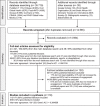Measuring patient engagement with HIV care in sub-Saharan Africa: a scoping study
- PMID: 36285618
- PMCID: PMC9597383
- DOI: 10.1002/jia2.26025
Measuring patient engagement with HIV care in sub-Saharan Africa: a scoping study
Abstract
Introduction: Engagement with HIV care is a multi-dimensional, dynamic process, critical to maintaining successful treatment outcomes. However, measures of engagement are not standardized nor comprehensive. This undermines our understanding of the scope of challenges with engagement and whether interventions have an impact, complicating patient and programme-level decision-making. This study identified and characterized measures of engagement to support more consistent and comprehensive evaluation.
Methods: We conducted a scoping study to systematically categorize measures the health system could use to evaluate engagement with HIV care for those on antiretroviral treatment. Key terms were used to search literature databases (Embase, PsychINFO, Ovid Global-Health, PubMed, Scopus, CINAHL, Cochrane and the World Health Organization Index Medicus), Google Scholar and stakeholder-identified manuscripts, ultimately including English evidence published from sub-Saharan Africa from 2014 to 2021. Measures were extracted, organized, then reviewed with key stakeholders.
Results and discussion: We screened 14,885 titles/abstracts, included 118 full-texts and identified 110 measures of engagement, categorized into three engagement dimensions ("retention," "adherence" and "active self-management"), a combination category ("multi-dimensional engagement") and "treatment outcomes" category (e.g. viral load as an end-result reflecting that engagement occurred). Retention reflected status in care, continuity of attendance and visit timing. Adherence was assessed by a variety of measures categorized into primary (prescription not filled) and secondary measures (medication not taken as directed). Active self-management reflected involvement in care and self-management. Three overarching use cases were identified: research to make recommendations, routine monitoring for quality improvement and strategic decision-making and assessment of individual patients.
Conclusions: Heterogeneity in conceptualizing engagement with HIV care is reflected by the broad range of measures identified and the lack of consensus on "gold-standard" indicators. This review organized metrics into five categories based on the dimensions of engagement; further work could identify a standardized, minimum set of measures useful for comprehensive evaluation of engagement for different use cases. In the interim, measurement of engagement could be advanced through the assessment of multiple categories for a more thorough evaluation, conducting sensitivity analyses with commonly used measures for more comparable outputs and using longitudinal measures to evaluate engagement patterns. This could improve research, programme evaluation and nuanced assessment of individual patient engagement in HIV care.
Keywords: adherence; engagement; evaluation; measure; retention; self-management.
© 2022 The Authors. Journal of the International AIDS Society published by John Wiley & Sons Ltd on behalf of the International AIDS Society.
Conflict of interest statement
There are no relevant financial or non‐financial competing interests to report.
Figures


References
-
- Atanga PN, Ndetan HT, Fon PN, Meriki HD, Muffih TP, Achidi EA, et al. Using a composite adherence tool to assess ART response and risk factors of poor adherence in pregnant and breastfeeding HIV‐positive Cameroonian women at 6 and 12 months after initiating option B+. BMC Pregnancy Childbirth. 2018;18(1):418. - PMC - PubMed
Publication types
MeSH terms
Substances
LinkOut - more resources
Full Text Sources
Medical

